#structural biology
Link
Recent breakthroughs in AI-based protein structure prediction have enormous potential to accelerate discoveries across the life sciences. However, major barriers persist in making these advanced tools accessible to non-experts without specialized computing resources. To address this gap, researchers from Joint BioEnergy Institute, US, have developed Foldy – an intuitive web application that puts powerful structural biology capabilities into any biologist’s hands. This article explores Foldy’s origins, key features, and example use cases highlighting its transformative possibilities.
In just a few years, AI models like AlphaFold have achieved dramatic leaps in accurately predicting protein structure from sequence. These methods hold tremendous promise for rational design, functional annotations, and revealing new biology.
However, major obstacles remain in applying them. Predicting structures requires heavy computing power – both GPUs and storage for the massive neural networks. This places AI-based structure prediction out of reach for many biologists.
Continue Reading
30 notes
·
View notes
Text

This is gonna be a niche ass post, but I wanna brag about my protein purification. Look at that pure ass protein.
5 notes
·
View notes
Text
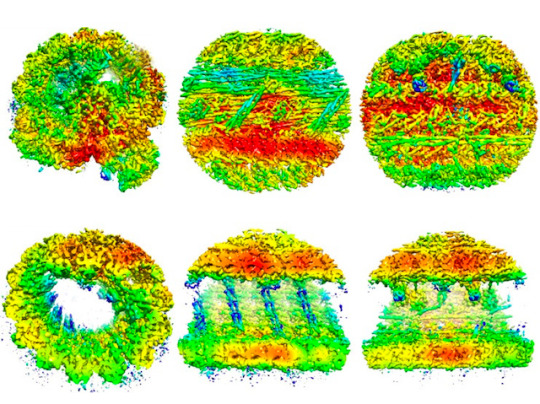
Building a Sperm
Combining protein structure predictions with cryoelectron tomography reveals proteins – novel and known – their structures, interactions and locations in intact mammalian sperm
Read the published research paper here
Image from work by Zhen Chen and colleagues
University of California San Francisco, San Francisco, CA, USA
Image originally published with a Creative Commons Attribution 4.0 International (CC BY 4.0)
Published in Cell, October 2023
You can also follow BPoD on Instagram, Twitter and Facebook
5 notes
·
View notes
Text
Mechanistic insight into odorant recognition
Our sense of smell is dependent on recognition of a vast array of odorants despite having a finite number of receptors. Odorants are mostly detected by G protein-coupled receptors called odorant receptors in olfactory sensory neurons. While there are only approximately 400 odorant receptors in humans, combinatorial activation of these odorant receptors enables sensing of odorants with diverse chemical structures. However, the mechanistic basis of odorant binding to odorant receptors in humans has remained unclear.
SBGrid member Aashish Manglik and other researchers have been working to develop a structural understanding of how odorants are recognized by odorant receptors. Using cryo-EM, they report the structure of active human odorant receptor OR51E2 bound to fatty acid propionate.
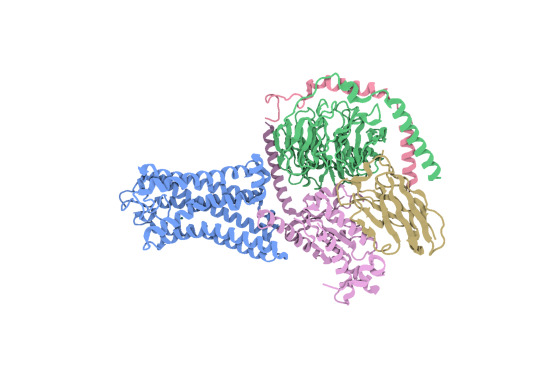
Above: Structure of human OR51E2 bound to propionate in complex with miniGs399. CC BY SBGrid.
Based on this structure, they determined that propionate is bound within a pocket in the odorant receptor and makes specific contacts to achieve activation. After mutating the odorant-binding pocket, they observed altered recognition of fatty acids with varied chain length. This suggests that activation of odorant receptors by odorants is influenced by tight packing interactions. Through molecular dynamics simulations, they show that propionate induces conformational changes in a specific region of odorant receptor OR51E2, extracellular loop 3. This work provides a foundational understanding of odorant recognition by human odorant receptors at a high-resolution, structural level.
Read more about this work in Nature.
#nature#science#cell#structural biology#sbgrid member research#sbgrid#biomedical research#cryo-EM#biomedicine#biomedical engineering
13 notes
·
View notes
Text
if anyone knows molecular docking can you please reach out to me please i need help asap or can you suggest different sites please
Im fucking losing it over a step
#please help#autodock#molecular docking#Chimera#pymol#bioinformatics#computational biology#biology#biotechnology#drug design#structural biology
3 notes
·
View notes
Photo

Dorothy Hodgkin was born on May 12, 1910. A Nobel Prize-winning British chemist who advanced the technique of X-ray crystallography to determine the structure of biomolecules, which became essential for structural biology. Among her most influential discoveries are the confirmation of the structure of penicillin as previously surmised by Edward Abraham and Ernst Boris Chain; and the structure of vitamin B12, for which in 1964 she became the third woman to win the Nobel Prize in Chemistry. Hodgkin also elucidated the structure of insulin in 1969 after 35 years of work.
#dorothy hodgkin#x-rays#biomolecules#biology#structural biology#penicillin#nobel prize#nobel prize winners#women in science#women in history#science#science history#science birthdays#on this day#on this day in science history
1 note
·
View note
Link
An Aston University researcher has created the first ever computer reconstruction of a virus, including its complete native genome. Although other researchers have created similar reconstructions, this is the first to replicate the exact chemical and 3D structure of a ‘live’ virus.
0 notes
Photo







Soooo, I generally DON'T get political or divisive in the strip... buuuuttt... it's PRIDE and, like with last week’s strip, I am kinda burnt out with seeing the same asinine arguments online over and over. Why do I have to defend my legal right to exist with people who learned biology from "Kindergarten Cop"?
#transgender#trans#lgbtq#lgbtqia#transgirl#biology#chromosomes#dna#male bone structure#terf#terfs#maga#trumpster#trumpster fire#murica#thumb#thumbwar#punchout#punch out#super punch out#80s#80s video games#videogames#vintage#retro#nes#nintendo#nintendo entertainment system
158 notes
·
View notes
Text
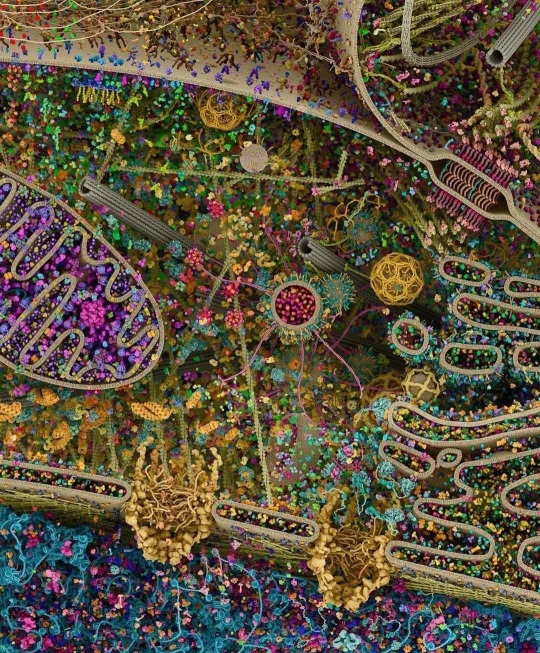
The most detailed model of ONE human cell to date, obtained using x-rays, nuclear magnetic resonance, and cryoelectron microscopy data sets. Aren't we all just so filled with magical possibilities?
Most recent estimates put the number of cells in one body at around 30 trillion. Written out, that's 30,000,000,000,000.
Source and Credit: Transformation of the Cellular Landscape through a Eukaryotic Cell, by Evan Ingersoll Ingersoll Gael McGill ~ Digizyme's Custom Maya Molecular Software
Biología Al Instante
* * * *
Endless and infinite waves of vibration lap upon the shores of our bodies. We float in a sea of frequencies as fish in those waters, and we are rarely if ever conscious of the fact. Instead we assemble a world by transforming those frequencies into a vision that exists in the uniqueness of our mind's eye only, and then we believe with great insistence that what we see is real, and deserving the stamp of "truth," without pausing to consider the alternative realities held equally dear by our fellow fish. How to pierce the veil and see what actually is, as opposed to the creations of our minds? I'm not even remotely sure to be honest! The mechanics of "seeing" guarantee that "how I see it" must be different than how another does. So perhaps "reality" is more of a composite to be assembled with the help of the whole school of us~ Or perhaps it is an alternative altogether different from anything a shared vision might come up with, given our capacity to witness it with our senses is ultimately inadequate. Either option is cause for humility. Just thinking out loud here!
(Gil Hedley)
#Gil Hedley#cells#biology#physiology#Biología Al Instante#Body Alive#Structural Integration Atlanta#quotes
43 notes
·
View notes
Text
Exploring the Marvels of Biological Macromolecules: The Molecular Machinery of Life (Part 3)
Proteins and Enzymes: Catalysts of Molecular Reactions
Proteins are the central players in macromolecular interactions. Enzymes, a specialized class of proteins, catalyze biochemical reactions with remarkable specificity. They bind to substrates, facilitate reactions, and release products, ensuring that cellular processes occur with precision.
Protein-Protein Interactions: Orchestrating Cellular Functions
Proteins often interact with other proteins to form dynamic complexes. These interactions are pivotal in processes such as signal transduction, where cascades of protein-protein interactions transmit signals within cells, regulating diverse functions such as growth, metabolism, and immune responses.
Protein-Ligand Interactions: Molecular Recognition
Proteins can also interact with small molecules called ligands. Receptor proteins, for instance, bind to ligands such as hormones, neurotransmitters, or drugs, initiating cellular responses. These interactions rely on specific binding sites and molecular recognition.
Protein-DNA Interactions: Controlling Genetic Information
Transcription factors, a class of proteins, interact with DNA to regulate gene expression. They bind to specific DNA sequences, promoting or inhibiting transcription, thereby controlling RNA and protein synthesis.
Membrane Proteins: Regulating Cellular Transport
Integral membrane proteins participate in macromolecular interactions by regulating the transport of ions and molecules across cell membranes. Transport proteins, ion channels, and pumps interact precisely to maintain cellular homeostasis.
Cooperativity and Allosteric Regulation: Fine-Tuning Cellular Processes
Cooperativity and allosteric regulation are mechanisms that modulate protein function. In cooperativity, binding one ligand to a protein influences the binding of subsequent ligands, often amplifying the response. Allosteric regulation occurs when a molecule binds to a site other than the active site, altering the protein's conformation and activity.
Interactions in Signaling Pathways: Cellular Communication
Signal transduction pathways rely on cascades of macromolecular interactions to transmit extracellular signals into cellular responses. Kinases and phosphatases, enzymes that add or remove phosphate groups, play pivotal roles in these pathways.
Protein Folding and Misfolding: Disease Implications
Proteins must fold into specific three-dimensional shapes to function correctly. Misfolded proteins can lead to Alzheimer's, Parkinson's, and prion diseases. Chaperone proteins assist in proper protein folding and prevent aggregation.
References
Voet, D., Voet, J. G., & Pratt, C. W. (2016). Fundamentals of Biochemistry: Life at the Molecular Level. Wiley.
Lehninger, A. L., Nelson, D. L., & Cox, M. M. (2017). Lehninger Principles of Biochemistry. W. H. Freeman.
Berg, J. M., Tymoczko, J. L., & Stryer, L. (2002). Biochemistry. W. H. Freeman

#science#college#biology#education#school#medicine#student#doctors#health#healthcare#proteins#molecular biology#molecular structure#chemestry#chemistry
96 notes
·
View notes
Text
I just think homology obliterates intelligent design purely because structures that serve radically different functions have exactly the same parts in them and yet structures with the same function are composed of totally different parts.
Why do whales have finger bones?? What could they POSSIBLY need them for?? Primates use them to grasp, carnivorans use them for walking and running. In whales they're still there but hidden uselessly inside flippers.
Why are bird wings so different from bat wings if they're both used for flying?? Why are both of these completely different from insect wings??
Why do ALL of these except insects have the same layout of bones?? Humerus, radius + ulna, carpals and metacarpals.

It's like building planes out of boat parts.
#intelligent design#intelligent design creationism#creationism#young earth creationism#evolution#evolutionary biology#homology#homologous structures#anatomy#comparative anatomy
68 notes
·
View notes
Link
Effective structure-based search tools are necessary to efficiently organize the massive volume of data in the database. Novel tools like FoldSeek and 3D-surfer have been developed as a result of the inability of existing tools like PDBeFold to handle huge datasets. However, they are limited in their functionality by the fact that they can’t search the entire AlphaFold DB and that they have to rely on pre-established fold patterns.
Because of this, researchers from Masaryk University created AlphaFind, a protein search tool that only looks at tertiary structure. It does this by automatically extracting the key 3D characteristics from each protein chain and then employing a machine-learning model to identify the structures that are the most comparable. AlphaFind is an effective protein structure tool that has shown exceptional scalability to big datasets and structures, making it possible to extract intricate and precise information.
Protein structural data are extremely useful scientific tools that form the foundation of increasingly important and productive research. Researchers currently have about 200 thousand experimental protein 3D structures deposited in the Protein Data Bank (PDB) as a result of seven decades of intensive research. Moreover, the protein 3D structure predictions generated by the AlphaFold algorithm, which was trained using this experimental data, are extremely dependable.
Continue Reading
26 notes
·
View notes
Text


A lil speculative biology for an assignment, ft one of my favorite pokeys.
#used mostly badger anatomy for it#dw aby the scientific name its lazy lol#pokemon#typhlosion hisui#skeleton#speculative biology#mashing the bipedal and quadrupedal shoulder structure was hard#since i know typh here can walk bith ways#weirdo!#also man. is it difficult to get a good turnaround of a badger skeleton...i did a lot of guesswork#with a few mid 3d models on sketchfab ahdbshf
27 notes
·
View notes
Text

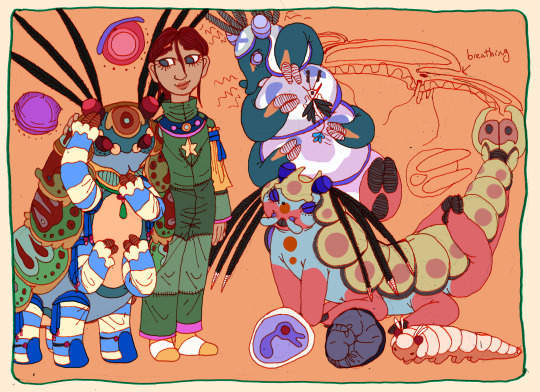
all about kkariko! the infodump is finally ready.
kkariko are soft-bodied invertibrate creatures hailing from a planet known as rika. they're social and familial, living in highly complex family groups. they also make extensive use of tools and accessories in their daily lives. in this way, their behavioral model resembles the behavioral models of humans, but kkariko have some major differences too. an example - kkariko have five "sexes" - or maybe they have no sexes? all kkariko are born "neuter", with the organs used for recreation vestigal in their bodies. however, kkariko can develop into one of four "sexual" sexes to play certain roles in mating and infant rearing. kkariko are able to switch sex multiple times in their lives - it's seen as cosmetic to them. the five socially recognized kkariko sexes are thus: neuter sex, the sex which kkariko are born as. egglayer sex, the sex which can inject pheromones into another kkariko, receive "spermatophores", and lay eggs. inseminator sex, the sex which can make "spermatophores" (actually more like "spear" matophores). brooding sex, the sex which can grow a pouch and grow eggs in it and feed babies using their specialized mouth organ. and finally, protector sex, which also has a special mouth organ and a "spine" for protecting babies.
kkariko babies start life as eggs. eventually, they hatch, and just look like tiny little kkariko. kkariko at such a young age molt many times, and with each molt, they grow more and more. molting intensity usually tapers off after the 27th molt, and size change only gets smaller and molt frequency lower as kkariko age. kkariko have very high infant mortality rates - on average, a clutch of kkariko eggs numbers 20, but its considered lucky if just 4 survive to their 27th molt. rrikrik was in a clutch of 17, but half were laid "out of pouch" (common in almost all kkariko cultures, ensures that brooder attention isn't so divided) and only two ended up hatching.
kkariko have two possible pigments used in their skin. one pigment creates red/pink colors, whilst the other creates blue/gray colors. both can coexist on a single body - like a calico cat - as well as patches of different intensity of pigmentation which can produce darker or lighter pigmentation. these pigments also determine the eye color of kkariko. however, kkariko tend to have a "base color" which affects the tint on their exoskeletons. base color isn't neccesarily the most abundant color on a kkariko.
their bodies are long and squishy, with thick, highly pressured "blood" keeping their muscles and organs in place. kkariko have four pairs of legs, and they alternate between an all-legs undulatory gait and a quadrapedal four beat gait depending on the movement speed and additional actions required of them. they can also stand up on their back legs for intimidation points. but their balance is pretty bad in this state and they can't walk without lots of practice and lower leg strength. at the end of each limb, they have three digits encased in flexible exoskeleton. two digits at the very end of the limb, and one slightly down. these digits can be used to grasp things and manipulate objects, although they're generally clumsy. they also have a long, fat, tapering tail. this tail can be moved independently, but is usually just dragged along the ground behind the kkariko due to its weight. kkariko have a small, round head at the end of their body, where many of their sensory organs are.
kkariko heads are pretty simple. it is on their head that a kkariko has their two pairs of eyes, their primary mucus ducts, their facial palps, their antennae, their mouth, and their first lung. the first pair of kkariko eyes are kind of a hybrid between forward-facing and side-facing. they've got a wide degree of vision. this eyeset sees pretty well, and is generally used to identify objects near the kkariko's face. for this reason, they're nearsighted. the second pair of eyes sits above the kkariko's head and protude upwards. this pair can see nearly 260 degrees around the kkariko, and experiences vision in a very abstracted way, largely triggered by bright colors and movement. these eyes also move independently of each other. as a prey animal, kkariko have evolved this set of eyes to continually watch around them as they use their first set of eyes to look for food and watch their friends. both eyes jut out from the head of the kkariko when in use. the lower set of eyes have a pair of semi-translucent eyelids which occasionally can hydrate the eye, but kkariko generally don't need to blink much. the upper pair of eyes don't need to blink at all, because they have a thick protective coating. both pairs of eyes are retractable, however, and when kkariko are getting ready to go sleep, they retract them back into their heads, with only a thin indigo line showing where they will pop out of later. just below their eyes is their primary mucus ducts, which produce a mucus which covers kkariko skin to keep it from drying out and getting burnt. there are more mucus ducts on their "wrists" and their tail.
the antennae sit behind the second pair of eyes, and are used to sense different types of waves and particles in the air. they process this into audible sound, vibrational information, and electromagnetic data. kkariko can have anywhere from three to five sets of antennae, and can grow an extra pair for sensing pheromones when engaging in sex. antennae can also be used to make a loud whirring noise when rubbed together or a low "clicking" noise when the bases of the antennae (known as "bulbs") grind together in the antennae sockets. these noises are recognized as distinct phones in kkariko language.
the mouth of the kkariko is typically hidden behind their exterior set of palps. these two tentacle-like appendages are used by kkariko to "taste" the air and food, to produce sounds, and to manipulate objects. kkariko palps have much finer motor control than their "hands", so delicate tasks like making art or preparing food are usually done using the exterior palps. behind these palps is the mouth. the mouth of the kkariko is indigo-violet (the color of their blood) and contains a pair of interior palps, two flat "teeth" used for crushing food, and a pair of holes, one used for communication and another used for eating. the interior palps are much thinner than the exterior palps, but serve the same purpose as their exterior friends. its a bit hard to use them to make art, as they can't reach that far outside the mouth. the lower tooth juts out of the mouth and can be moved with a good degree of freedom. when a kkariko's mouth is closed, it pushes up under the palps and the edges of the mouth retract around it, leaving the lower tooth as the only mouth organ visible. when the mouth is open, the lower tooth keeps it by moving down. the lower tooth and the upper tooth mash together to grind food up into a convenient paste, and then the interior palps and kkariko saliva helps move the food down to the esophagus, which is situated below the palps. above the palps is the kkariko's speech hole - closed during eating. kkariko are kind of messy eaters!
kkariko language is, as previously discussed, in part constructed around antennae sounds. but there is a vocal element of it too. kkariko have several groupings of lungs down their bodies, and the first lung sits at the back of their head just below their first cerebral ganglia, which is part of a long network which also travels all the way down their bodies. the lungs of the kkariko intake air from little holes underneath the "lip" of their back exoskeletons. this first lung is connected to the very end of their second exoskeleton plate, which wraps around their head to support it. connected to this lung is an "accordian" organ, which produces a melodious buzzing noise by expanding and contracting with pushed air from the lung out to the noise hole at the top of the kkariko's mouth. tone and intensity can be adjusted, and kkariko will adjust the position of their two pairs of palps and their tooth to make different noises with it. kkariko also rumble their teeth together and smack them together to speak.
on their backs, kkariko grow a heavy plated exoskeleton, used for defense and protection. this exoskeleton stretches from the head of the kkariko all the way down to their tail, ending in a spiked fanlike form which can be used to defend a kkariko. rika is very rich in metal, and heavy metals often enter kkariko diets via the plant life they eat. kkariko have very efficient filtering systems for both water and metals - water is recycled back into the body entirely and eventually expelled in defensive, stinking "farts", and metals are either pooped out in very hard and compacted dry poops, or stored in a specialized organ and used to built their exoskeletons during molts. this is where the colors in their exoskeletons come from - all the metals they eat. some of the metals even oxidize in air, and change color as time moves on! this metallic shell is very heavy, and because of that, kkariko have very strong and muscular bodies. the gravity on rika is also pretty strong, so that also aids in their big buff physiques. the exoskeleton restricts their movements somewhat - kkariko are able to move their limbs pretty freely, and can curl up into a tiny ball, but cannot arch their bodies back that far because the plates on their back prevent much movement. the kkariko in this sheet doing some sort of stretching is probably the extent to how far back a kkariko can stretch without hurting themselves.
kkariko culture is highly complex and varied. rika is hot and arid, and many kkariko live nomadic or seminomadic lives. i'll probably write another post about kkariko cultures, because this one is very long. i guess the most important thing to discuss here is kkariko fashion. kkariko are generally not very modest - they don't need to be, because their shell protects them from most weather. however, all cultures are different, and some kkariko do wear full-body clothing. the most common universal piece of clothing are "armwarmers", which wrap around the limbs like socks. kkariko often wear matching pairs for all eight of their limbs. bibs, hats, capes and aprons are also common, as well as tail aprons which protect the tail from sharp terrain when moving across the ground. tail aprons are a bit like underwear because they also cover genitals.
rowny and rrikrik for reference. rowny is 6ft tall.
v page i made when i was trying to figure out how kkariko communicate + kkariko funny faces v
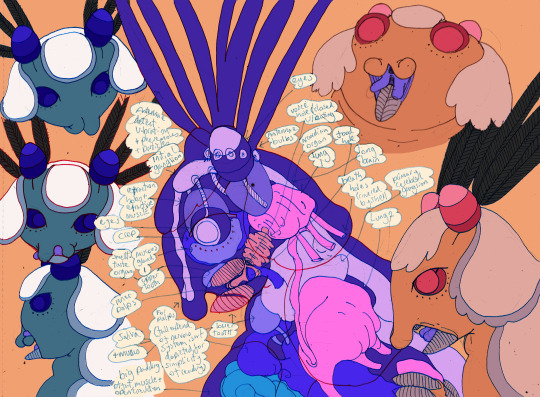
#kkariko tag#xenobiology#speculative biology#sci fi#alien biology#alien species#the kkariko infodump....#new deep kkariko lore - their poop is hard and they fart#writing this two weeks after - “lung” structure has changed a bit. think of it less as a bag and more as a root system
82 notes
·
View notes
Text
Understanding how iron affects stearoyl-CoA desaturase-1 activity.
Enzymes are the manufacturing facilities of the cell. They take the materials provided by the environment and convert them into cellularly relevant chemicals. The physical processes that allow enzymes to do this vital work are of interest to scientists because of the possibility of treating enzyme-related diseases, using enzymes as therapies for neurodegenerative diseases, and harnessing their manufacturing process for production of chemicals relevant to society. In a recent study by SBGrid member Ming Zhou from Baylor College of Medicine, the maintenance and function of a subclass of enzymes becomes more apparent.
Stearoyl-CoA desaturase-1 (SCD1) is an enzyme that localizes in the endoplasmic reticulum of cells and contains two iron atoms at its core. SCD1 uses the core irons to carry out the catalytic function of adding a double bond to fatty acids, thus creating unsaturated fatty acids. This enzyme contributes to diseases like cancer and diabetes and is a possible target to treat neurodegenerative diseases. Zhou and colleagues pursue an answer to how and why SCD1 loses enzymatic activity after a certain amount of uses.

Above: Published structure of SCD-1 diiron active site. PDB: 6WF2. CC BY SBGRID
Similar to common machines in a household, enzymes stop functioning after a certain number of uses. Understanding why a machine stops working can provide insight about how to keep them working longer and more effectively. Zhou and company used enzyme activity assays to show that SCD1 lost function after 8.5 reactions due to the loss of an iron from the active site of the enzyme. The team used UV-vis spectroscopy, EPR, and inductively coupled plasma mass spectrometry (ICP-MS) to confirm that the loss of activity was due to the loss of iron in the active site. They also found that this iron loss could be remedied by providing an excess of available iron for SCD1 to take up and continue its work, though once SCD1 becomes inactive this treatment can not restore activity. This provides a possible “repair” for low SCD1 activity by ensuring that it has a large pool of possible iron molecules with which to maintain its function. This study provides interesting insight into how to limit and possibly prevent enzyme self-inactivation.
Read more about this work in the Journal of Biological Chemistry.
-Vida Storm Robertson, Fisk University
4 notes
·
View notes
Text
Human corneas are incredibly similar to shark corneas
#studyblr#notes#my notes#biology#bio#human biology#human bio#anatomy#human anatomy#anatomical vocabulary#anatomical variation#medblr#medical notes#med notes#anatomical structures#human anatomical structures#anatomy and physiology#anatomy & physiology#life science#biological science#note cards#flashcards#flash cards
27 notes
·
View notes